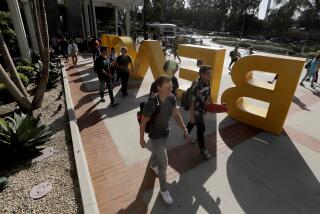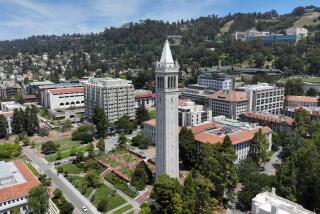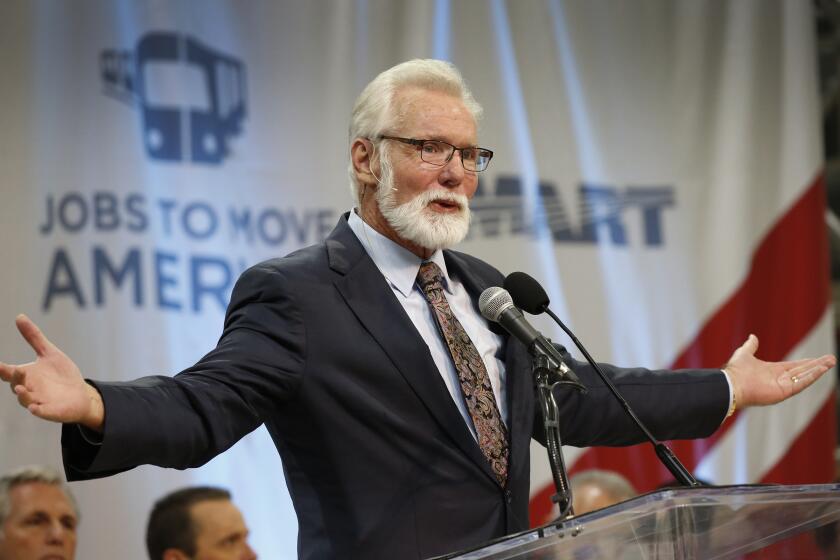UC wants to enroll 3,600 more Californians next year, but funding shortfalls threaten plan

- Share via
The University of California wants to enroll nearly 3,600 more California students in the next academic year but is bracing for a looming budget crunch that could make it difficult to pay for increased enrollment.
UC officials told regents Wednesday that the 10-campus university system could face a $504.7-million financial shortfall in 2025-26 if the state makes good on warnings earlier this year to reduce higher education funding as it grapples with a budget deficit. Lower state funding, along with higher costs primarily driven by faculty and staff pay increases, larger retirement plan contributions and more expensive healthcare, are projected to create that yawning UC budget hole.
“We’re facing a really tough budget year from the state,” Chief Financial Officer Nathan Brostrom told regents, who are meeting in San Francisco this week.
Brostrom said UC hoped to stick to its plans to increase California student enrollment — proposing to add 2,044 more undergraduates and 625 new graduate students in 2025-26 — calling that a “top goal” regardless of state funding decisions.
More questionable, however, is whether UCLA, UC Berkeley and UC San Diego will still give an additional 902 California students highly coveted seats in place of out-of-state and international students if the state cuts back funding that offsets the loss of the higher tuition that nonresidents pay.
Tuition will almost certainly increase for incoming California, out-of-state and international students under UC’s five-year plan approved in 2021 allowing one-time hikes for each entering class.
Regents will vote Thursday on the 2025-26 budget proposal, which is meant to list UC’s funding needs and priorities in advance of Gov. Gavin Newsom’s state budget plan unveiled in January. UC will adjust its plan depending on what the state ultimately enacts in June.
The timing is challenging for UC, which begins issuing offers of admission in March before it knows with certainty how much state funding it will receive. But both UC and the state are prioritizing enrollment increases.
In the last several years, UC has been pummeled by demands to open more seats for Californians — including pressure by lawmakers — and has enrolled about 7,800 more California undergraduates between 2022-23 and 2023-24. Preliminary estimates for this academic year indicate campuses enrolled an additional 3,000 students, boosting the total number of California undergraduates to more than 206,000, the most in UC history.
The University of California admitted the largest, most diverse class of Californians for fall 2024, with gains in low-income, first-generation and underrepresented students.
Campuses hope to continue adding nearly 3,000 more California undergraduates annually through 2026-27.
But how UC will pay for that growth is up in the air. In its final budget in June, the state told UC to expect a 7.95% cut in funding in 2025-26, plus a one-time deferral of about $240.8 million pledged as part of the five-year compact with Newsom.
The compact called for 5% annual budget increases tied to boosting California student enrollment, improving student success, closing achievement gaps, enhancing affordability and supporting career training. The state also told UC to prepare for a deferral of $31 million in funding to offset the financial hit of replacing nonresident students with California undergraduates at UCLA, UC Berkeley and UC San Diego.
The state plans to return some funding deferred last year, but the overall reduction will amount to 5.6%, or more than $270 million.
California State University is facing a similar financial squeeze, projecting a budget hole of $400 million to $800 million after receiving similar warnings of state funding reductions. Some trustees have expressed exasperation at state expectations to increase California enrollment and help students graduate to help fill projected workforce shortages while reducing funding to do the work.
At UC, Student Regent Josiah Beharry expressed irritation that the state may not honor its funding commitments.
“That’s very frustrating that we’re doing our part and it’s hurting our campuses,” said Beharry, a UC Merced graduate student.
At the same time, UC faces higher expenses, expecting to spend nearly $344 million more for employee pay and benefit increases. The planned enrollment increase will cost nearly $63 million, and financial aid for the new students and other tuition adjustments more than $100 million.
UC also is asking the state for $1.36 billion in one-time funding to renovate aging campus facilities and build new classrooms, labs and other projects. But officials acknowledged that the request would probably be turned down given the state’s estimated $28.4-billion budget deficit in 2025-26.
One source of new funding in UC’s 2025-26 budget plan is tuition increases — a proposed 3.5% for Californians and 9.9% for out-of-state and international students.
A five-year plan approved by regents in 2021 allows a one-time tuition increase tied to inflation for each class of incoming undergraduates, with no further changes for as long as six years to provide a stable source of revenue for campuses and predictable college costs for students. The tuition plan also set aside a larger share of the revenue raised for financial aid.
The 9.9% proposed increase for nonresidents would raise the supplemental tuition they pay to $37,602 in addition to the 2025-26 base tuition for all students of $14,934 — which includes the 3.5% increase.
The proposed nonresident tuition increase drew opposition from some students during the meeting’s public comments Wednesday. They praised the diversity that peers from other states and countries bring to campus; a few criticized UC for giving substantial raises to chancellors earlier this year while proposing to impose more financial strain on students.
“You are taking money out of the hands of those who need it most,” one student said.
Trump’s presidential term could bring sweeping changes to financial aid, impact UC research funding and eliminate protections for LGBTQ+ and undocumented students.
UC leaders acknowledged the November elections during the meeting.
Academic Senate Chair Steven W. Cheung said the outcome has raised myriad questions for UC — whether funding for financial aid will be slashed, fragile gains in racial and gender equity undone, clean energy and fetal stem cell research buried and access to healthcare lost. President-elect Donald Trump is expected to usher in sweeping changes for schools, colleges and universities.
In opening the meeting, Board Chair Janet Reilly said the outcome has triggered worry, fear and anxiety in some people, emotions she shared.
She encouraged those distraught over the election to seek spaces of healing and pledged UC’s “unwavering commitment” to continue serving society with higher learning, research and public service.
“To those who feel defeated, scared and marginalized, we see you, and we are committed to being a force of support for you now and in the future,” she said. “We are in this together.”
More to Read
Sign up for Essential California
The most important California stories and recommendations in your inbox every morning.
You may occasionally receive promotional content from the Los Angeles Times.













